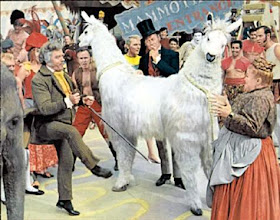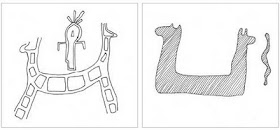British explorer George Chaworth Musters (who rode all the way from Punta Arenas on the Strait of Magellan to Carmen de Patagones on Patagonia's northern border in 1870), took note of the Tehuelche native beliefs and recorded a strange myth.
Two-headed Guanaco myth among the Tehuelche.
Musters wrote that:
"Another superstition is that a two-headed guanaco exists in the south, the appearance of which is forerunner of sickness".
He added that after the last time it was sighted, measles spread among the natives, killing many of them.
Guanaco belong to the Camelidae, which consists of a several species: two in the Old World (camels,in Africa and Asia) and another four members in South America, the New World camelids: llamas, alpacas, vicuñas and guanacos (the last two were never domesticated). Today we will look into myths regarding two-headed camelids in Southern South America. Some of these myths are found in Patagonia, others are from further north, mostly from the "land of the Inca", in northern Chile, Argentina, and of course, Peru and Bolivia.
As we have posted elsewhere (Cryptids - including two-headed snakes of Inca origin), the Inca had a strong influence on the other natives (they invaded Chile and Argentina, incorporating part of their territories into their empire in the XVth century) and many of their myths were absorbed by the conquered people.
Despite this, I think that the remote Tehuelche, isolated in the Patagonian steppes were not subjected to this cultural influence, so the two-headed guanaco myth is most likely of pre-Inca origin.
The Pushmi-Pullyu
Perhaps the older readers will remember a 1967 film, Dr. Dolittle starring Rex Harrison and Samantha Eggar. In this movie, there was a pushmi-pullyu, an imaginary breed of llama, which was two headed.
Its name, which sounds Inca, is a pun (combining the English words "push me" and "pull you") about the difficulties the creature faces when walking, as both heads want to lead the way.

Movie still from Dr. Dolittle, 20th Century Fox, 1967.
Native two-headed llama in Chile.
The natives of Northern Chile (and this is well beyond Patagonia), in the Lasana Valley, in Antofagasta, depicted two-headed llamas in their rock-art. The following examples are from Pona (22°17'S, 68°38'W), they show these creatures (one of them apparently carrying a person):[2]

Two-headed llamas - Chile. From [2]
This mythical creature must have permeated into Chile from Peru, the home of the Inca people.
Qarqacha de Peruvian bicephalic llama.
Peruvians (in the Huancavelica region) believe in a similar monster, the Qarqacha or Jarjaria.
It gets its name from its strange laugh ("qar qar") -while "chas" means dirt. It is a human that has been punished by God for some evil sin (mainly incest) and at night morphs into a deformed llama (mostly two-headed) or some other bizarre beast.
Without any doubt, this monster myth is intended to frighten people to keep them on the "straight path" and avoid the temptation of incest in small communities.
Argentina's two headed camelids.
In Argentina, at the Peña Colorada site, in Antofagasta de la Sierra, Catamarca province, there are also representations of bicephalic llamas. These date back to the formative period (ca. 500 BC).

Two headed camelid - Argentina. From [4]
Bibliography.
[1] Musters, G. (1873). At home with the Patagonians. pp.192.
[2] Aballay Y., E. and Rojas V., J. El arte rupestre del valle de Lasana
[3] Cavero Carrasco, R., (1990). Incesto en los Andes: las "llamas demoníacas" como castigo sobrenatural. Ayacucho: CONCYTEC. pp 171
[4] Podesta, M., Rolandi, D., Raffinio, R., Proaño, M. (2005). El arte rupestre de Argentina indígena: Noroeste Grupo Abierto Communicaciones. Chapter: Pastores y Argicultores Tempranos. La diversidad en el arte. Fig.4.
Patagonian Monsters - Cryptozoology, Myths & legends in Patagonia2010 International Year of Biodiversity Copyright 2009-2010 by Austin Whittall ©

wow!!!!
ReplyDeleteI'm the editor of the Calpaca "Connection" newsletter, and would LOVE to publish this in our next issue. With all attributions, of course, may I have your permission to do so?
ReplyDelete--L'illette Vasquez